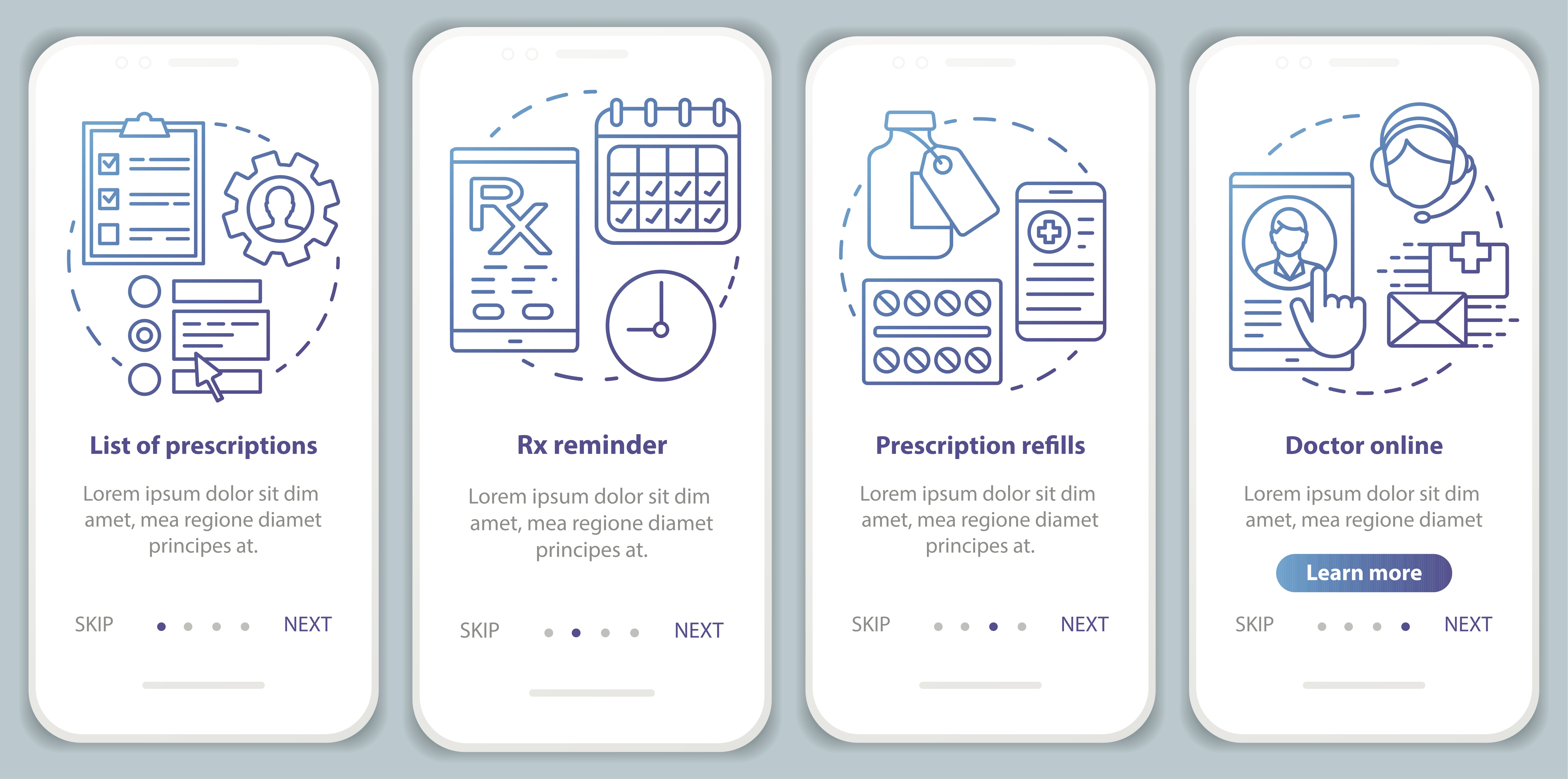The US Food and Drug Administration (FDA) receives over 100,000 reports each year concerning suspected medication errors. Worse, an estimated 7,000-9,000 people die every year in the US due to such mistakes. Perhaps, handwritten prescriptions are not to blame for all of these errors, but changes to the current prescription process could help address the pervasive problem.
Handwritten prescriptions are outdated and cumbersome for all participants in the healthcare sector. Fortunately, e-prescribing software is a solution for this issue, whether it’s used as a standalone app or integrated into an Electronic Health Records (EHR) or Electronic Medical Records (EMR) system. Electronic prescriptions go from doctor to pharmacist to hospital administrator to insurer accurately, quickly, and easily. Read also: Custom EMR Software Development Guide
ePrescribing, or eRx, software digitizes prescriptions and plays a critical role in eHealth. Keep reading to discover why to develop an e-Prescription app and how it works.
e-Prescription Software Trends After COVID-19

The global e-Prescribing market was valued at $1.2 billion in 2020 and is projected to be worth $3.3 billion by 2025. Some of this growth will result from the increased adoption of remote solutions during the pandemic.
COVID-19 has expedited the use of digital systems in healthcare, with more companies willing to invest in new patient care options. Electronic records are not new, but innovations in support systems have advanced digital solutions and lowered the entry barriers for even smaller care providers.
In addition to increasing the focus on telemedicine, the pandemic also created a need for contactless healthcare systems. While some patients could be treated remotely, those who couldn’t, needed to have limited contact with hospital employees.
So, while an in-person appointment with the doctor might be necessary, everything else — prescriptions refills, insurance discussions, and other services — was handled online. An electronic prescription software is one option to streamline patient interactions.
In addition to limiting contact, the pandemic encouraged systemic analysis of ways to reduce healthcare costs. One easy target is the elimination of unnecessary expenses. EHRs have been shown to improve the efficiency of practices and save costs.
So could eRx. The US spends more than $40 billion each year on errors associated with medication. Eliminating costs associated with errors saves money and improves safety.
The increased volume of patients in hospitals during the outbreak also highlighted the need for better data management — possible through increased digital records use.
A Markets and Markets report noted that the integration of telemedicine, EHR, and e-Prescribing software resulted in a network that relied on healthcare information technology, or HCIT, for diagnosis and prescription during the pandemic.
Government mandates, or encouragement, have also increased HCIT adoption. In the US, for example, the Centers for Disease Control and Prevention (CDC) recommended using telemedicine. At the same time, the Drug Enforcement Administration (DEA) introduced regulations requiring electronic medical prescriptions for controlled substances.
Read more about healthcare technology trends to watch in 2021-2023.
How e-Prescription Software Works

Before developing your own e-Prescription software, let’s dive in how it really works. eRx software is flexible. It can be deployed on mobile devices as well as desktops, be web-based or require installation. Regardless of its type, the primary role is enhanced drug management.
Providing information
When a patient makes an appointment, the doctor can use an integrated e-Prescription system to access their insurance coverage details. This way, the physician can prescribe a drug covered by the patient’s medical insurance.
The e-Prescription system obtains information from the pharmacy benefit management (PBM) files. The PBM maintains a list of drugs covered by a medical plan called the “formulary.” It allows the doctor to see all drugs that can be prescribed under the patient’s plan. The doctor can also use e-Prescription software to make additional requests, such as alternative drug suggestions.
Showing prescription history
Apart from insurance coverage information, e-Prescribing software can give the doctor access to the patient’s prescription history, helping to reduce medical errors.
Once the doctor selects the most appropriate medication, the eRx software is used to send the prescription to the pharmacy. If multiple pharmacies can fill the prescription, the patient can choose the most convenient one.
The chosen pharmacy will then check for availability and prepare the drugs for pickup. If the pharmacy needs any clarification regarding the prescription, it can use the same electronic prescription system.
Easy refills
A refill is even simpler. The pharmacy requests the refill on behalf of the patient, the doctor sees the request via the e-Prescription application and approves (or denies) it.
All this highlights the benefits of eRx:
-
The convenience of digitization. Since the paperwork, including insurance coverage details, is handled and verified electronically, all a patient has to do is pick up the prescription.
-
EMR/EHR integration. e-Prescriptions are stored electronically and can be integrated into your current EMR/EHR system. This enhances long-term access to accurate medical data and eliminates issues with filing and storing records.
-
Reduced prescription errors. Handwritten prescriptions increase the chances of medication-related mistakes, including the ones made by pharmacists and patients when reading the prescription.
Read also about the cost to develop a medicine reminder application.
Features That Make a Great e-Prescribing Software

Developing electronic prescribing systems should make it easier and more efficient to manage a clinic’s workflow. But an eRx application works best when integrated with an EHR/EMR system for smoother and faster processing. Let’s take a look at some essential features it needs to have.
Intuitive prescription process
The application needs an intuitive and user-friendly way to create new prescriptions for each patient. This means forms to specify drugs, dosage, frequency, and so on. The notes and comments option would be beneficial too. Every prescription must be saved and added to the patient’s record.
All healthcare data relevant to the physician, the pharmacist, and the patient must be readily available. If the solution is integrated with an EMR/EHR system, the doctor has to be able to search for the patient’s medical record and treatment history while writing a prescription.
Medical & administrative features
Beyond the basic prescription process, additional features can provide access to databases outside the e-Prescribing software for physicians and healthcare administrators. For example, doctors should be able to search and identify drugs through integration with a “drug dictionary” or health information networks like Surescripts.
Some essential features include:
-
Access to each state’s prescription drug monitoring program (PDMP) database in the US to track prescriptions, especially for controlled medication.
-
Basic clinical support needs to be provided to warn of possible drug reactions based on medical history.
-
Digital pre-authorization to confirm a patient’s eligibility for specific medications. This is especially true in the US, where the pharmacy benefit management (PBM) system decides which prescription drugs are covered by insurance.
-
Location awareness to help doctors or physicians direct a patient to the nearest pharmacy.
Security & legal features
All medical and health applications that collect data need to have the latest and, most importantly, compliant security features since non-compliance has legal repercussions. Here are some examples of the features that may be required by law, depending on where you’re operating.
-
Multi-factor authentication should be incorporated when handling sensitive information, even if the feature is not required by law. In the US, DEA mandates that all eRx providers have two-factor authentication to authorize prescribers.
-
A reporting function that allows clinicians and pharmacies to check and record a patient’s eligibility to access controlled medication. Digital signatures also offer a way to verify prescriptions on pickup.
-
A secure communication channel, like a live chat or call function, that connects pharmacists to physicians if clarification is needed. It’s more efficient than an unrecorded call outside of the system.
-
Backend services that are HIPAA and GDPR compliant, especially for data storage.
Now that you know the features an eRx application needs to have, the question is whether you need an app that’s standalone or integrated with an EHR system.
Developing a Standalone e-prescribing software vs. Integrating a Solution into Your EHR/EMR System

e-Prescribing applications are most efficient when integrated with EHR/EMR systems and other healthcare IT (HCIT) solutions like a healthcare CRM application. However, if a standalone app meets all your needs, it’s okay to use it separately.
Building e-Prescribing software
A standalone eRx system is a single system that is independent and doesn’t connect to your other HCIT systems. Choosing a separate app makes sense if you don’t rely heavily on the EHR/EMR framework. However, standalone systems are being phased out from HCIT and replaced by cloud-based eRx software development.
Pros:
-
Standalone e-Prescribing applications can be cheaper as they involve one-time development expenses, plus some recurring maintenance costs.
-
Choosing to develop your own solution means having a system that works with your unique business requirements.
-
You can create a system that mirrors your current workflow, making it easier for your business to transition to it.
Cons:
-
Separate applications are generally less efficient and have fewer functions when compared to the integration of e-Prescribing with EHR/EMR systems.
-
You will have to manually transfer all clinical data between your standalone system and your EMR/EHR solution. Manual processes increase the chances of errors and require more time.
-
The application won’t be able to access the patient’s historical medical data.
-
It takes longer to develop your own solution from scratch compared to integrating an existing solution.
-
Your business will eventually have to move to an integrated solution since the latest HCIT applications are more cloud-based with efficient application programming interface (API) integrations.
Integrating an e-Prescribing solution into an EHR/EMR system
It’s no secret that apps are more efficient when they have access to more information. Integrating eRx software into existing healthcare apps or HCIT systems provides the same benefits.
A market report by Mordor Intelligence says that by 2019, the biggest share of the e-Prescribing market was for web- and cloud-based applications. Generally, these are systems that have an API to integrate with existing EMR/EHR systems.
Read also: APIs in Healthcare Explained
Pros:
-
Greater efficiency and more functions for both the eRx application and your EMR/EHR system.
-
e-Prescribing integration with EHR/EMR systems is the more scalable option since cloud-based solutions are more conducive to rapid growth.
-
You get to choose the best solution available on the market and deploy it in a relatively short time frame.
Cons:
-
In addition to the cost of development, recurring maintenance costs and subscription fees may arise.
-
You might not get all the features you want, so you’ll have to make changes to your workflows.
-
A modified workflow implies a learning curve for physicians and other users to make full use of both e-Prescribing and an integrated HCIT system.
Of course, your e-Prescribing integration or development is only as good as the vendor you choose.
Choosing the Right e-Prescribing Integration Partner

An e-Prescribing module that’s linked to your EHR/EMR system will give you a single digital database with all relevant patient information. But moving from paper prescriptions to e-Prescriptions should be painless, with minimal disruptions to your work. To achieve this, you need a developer who has successfully implemented EMR/EHR applications and healthtech solutions before.
Poor integration could negate the benefits of developing a doctor’s prescription app. So, to avoid that, select a vendor that meets the following requirements.
Experience in building health applications
The regulations concerning healthcare solutions are very specific and vary depending on where you’re operating. eRx apps need to be developed or integrated by a vendor who has successfully implemented regulation-compliant healthtech solutions. For example, Demigos knows how to develop healthtech apps that are efficient for both the owners and the users, designing them with compliance in mind from the start.
Comprehensive understanding of the tech stack
Choose a team of developers familiar with the optimal tech stack for EHR/EMR systems. A consultant or advisor with experience in healthcare should tell you which tools, frameworks, and languages work best in your case. Developing web-based e-Prescribing solutions also requires expertise in cloud computing if you want the application to be web-based.
Cost to develop e-prescription app
To maximize your budget, choose a vendor with the skills-to-cost ratio that meets your requirements. Outsourcing is usually more cost-efficient than hiring an in-house team, so taking your time to find an outsourcing vendor who has experience in healthtech is a kind of investment. You can roughly calculate the cost of e-prescribing software development as the sum of all tech team member salaries plus the outsourcing vendor’s fee.
Product management
Management is a critical skill in software development projects. You need a single point of contact who understands your business needs as well as the software development process. Developing a medical prescribing app will require time, and clear communication will always be key to getting the results you want.
Final Thoughts
Integrating or developing eRx software means taking a step forward in an increasingly digital health sector. Patients want faster processes, and healthcare providers want efficiency and cost savings. And, of course, no one wants to sacrifice accuracy or safety. On top of that, all features must meet stringent regulatory requirements. In an environment like this, developing a custom eRx software is a challenge, so you need the right software vendor to guide you.
If you’re interested in e-Prescribing integration services, Demigos has a proven track record as a healthtech vendor. We successfully developed numerous EMR/EHR and billing solutions and can help you get the most from your eRx integration. We always choose appropriate functions to future-proof your business, and we look forward to helping you move forward with confidence.






